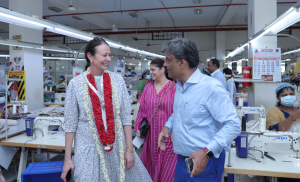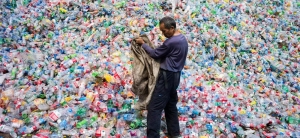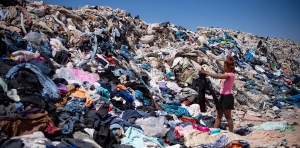Fibre Focus: Fish Leather
Choosing a fibre form a design perspective can be challenging enough, but the fibre that a fabric is made from also has numerous environmental and social impacts. It can be difficult to work out the best option when selecting a fibre.
Introducing Fibre Focus, our fabric blog that breaks down the various impacts of a fibre from an environmental, social justice and design standpoint. It is also important to consider any potential impacts a fibre may have if it were to become more popular.
Fish Leather:
Design advantages:
• Derived form a by-product, so very cost effective to source
• Naturally rich in oils, so the end product is supple and durable if treated correctly
• ‘Fish leather’ is a very versatile material that has a wide range of applications in a number of industries – from footwear, to fashion, to furnishings
• Has affinity with most dyestuff, natural or synthetic
Design disadvantages:
• Compared to large-bodied cows (that are used in conventional leather) fish obviously have much smaller bodies and more are needed to make the same amount on animal leather
• Although fish leather is derived from a by-product that might otherwise be wasted, it is still technically an animal product, and therefore some vegans/vegetarians may disapprove
• Fish skin is generally finer and less durable than leather derived from animal hide
• Fish skin can tare easily during the production phase if precautions are not taken
Environmental impact:
• Natural, biodegradable, renewable (for now!)
• Derived form a waste product, so nothing ‘new’ was raised or cultivated for fish leather production – thus saving precious natural resources and avoiding extra emissions/pollution
• No issues with post-use disposal because fish leather degrades back to nature
• Fish are ubiquitous in many of the world’s water bodies – and so do not necessarily need to be imported. This saves distance, fuel and emissions
• However overfishing or irresponsible fishing is an incredibly disruptive practice – did you know that the infamous Great Pacific Garbage Patch is up to 46% discarded fishing paraphernalia?
• Rearing cattle for leather and the meat industry uses vast quantities of land, water and chemicals. It can also lead to deforestation – whereas fishing does not require the clearing of land
• Cadaver-wise, more fish are needed to produce the same quantity of animal leather – although if the fish are already dead, then perhaps it makes sense to utilise their skin?
• Conventional leather generally goes through a ‘tanning’ process where a cocktail of heavy metals including Chromium 6 are used to treat the hide. Fish leather does not require these chemicals.
Social impacts:
• Fishing communities can sell excess skins and generate a secondary stream of income
• Improved worker health during the tanning process and the avoidance of Chromium 6 and other heavy metals that have known negative health implications
• People can buy fish skins from their local fishmongers and create their own fish skin leather in their kitchens at home
• Residential areas surrounding conventional leather tanneries are routinely exposed to residual chemicals in their water sources, fish skin leather avoids this issue
Positive potential impacts:
• Avoidance of chemical pollution such as Chromium 6
• Increased profits for fishing communities
• Less waste in the fishing industry
• Less fuel required for transportation
• Decreased deforestation rate
• Increased biodiversity and ecological equilibrium
• Decreased presence of synthetic ‘leather’ alternative in landfill, and therefore improved land, air and water quality
• Better health for workers and a decreased risk of chromium related illnesses in local communities. The tanning chemicals used in animal leather production have an undeniable link to severe neurological issues in children
Negative potential impacts:
• Job loss in cattle industry
• Job loss in leather industry
• Overfishing, decreased biodiversity
• Increased waste levels in meat industry – if the demand for meat remains high and the demand for animal leather falls, the animal skins will go to waste and so will all the resources used for rearing the animals
• Slightly different look that normal leather, which may take some consumers a while to get used to
So, there you have it, a simple breakdown of fish leather’s impacts that you can keep in mind when buying, sourcing or designing.




